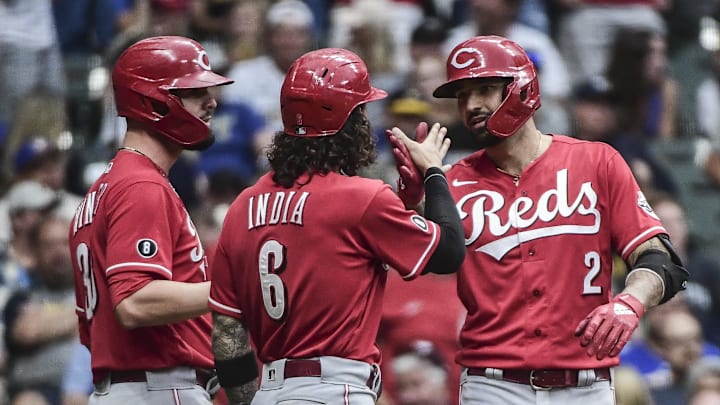Much has been made of the cost-cutting approach the Cincinnati Reds front office has taken this offseason. In 2021, the Reds finished 83-79, and were in contention for the postseason until the lsat couple weeks of the season.
What if the Reds had stayed the course? What if, instead of trading away some of their most beloved and talented players, Cincinnati's front office gave it another try with the same group that finished sixth in the National League last season?
Instead of Tommy Pham, Colin Moran, Donovan Solano, and Mike Minor, what if the Reds fielded a team with Nick Castellanos, Eugenio Suárez, Jesse Winker, and Sonny Gray? Is that a team that would've contended for the National League pennant? The better question might be, what would that team's payroll have looked like?
Would the Reds payroll would have been astronomical in 2022?
Okay, let's set the parameters for this hypothetical scenario before we dive off the deep end. Assuming no trades were made, all player-options were picked up, and all free agent and arbitration-eligible players were retained for the salary they'll be receiving in 2022, what would the Cincinnati Reds payroll look like?
Let's start with the starting rotation. Under this assumption, Wade Miley would have been retained for $10M and Sonny Gray would not have been traded to the Minnesota Twins. Luis Castillo and Tyler Mahle agreed to one-year contracts and avoided arbitration.
Miley and Gray would combine to make $20.2M in 2022. Castillo settled for $7.35M and Mahle is estimated, per Spotrac, to make $5.5 during the upcoming season. Gutierrez would be making the league minimum of $700K, meaning the starting rotation would account for $33.75M.
Let's move on to the starting lineup. The Cincinnati Reds infield of Joey Votto, Jonathan India, Kyle Farmer, Eugenio Suárez would account for $39.85M of the Reds payroll. The Reds shed the $11M owed to Geno, but are still on the hook for Votto's $25M.
But let's not forget the Cincinnati Reds universal designated hitter, Mike Moustakas. Moose is signed for two more seasons and will take home $16M this season. And, if we're assuming that all player-options were picked up, the Reds would owe former catcher Tucker Barnhart $7.5M in 2022. Barnhart's backup, Tyler Stephenson would be making the league minimum.
Now let's look at the outfield of Nick Castellanos, Jesse Winker, and Nick Senzel. Assuming the Reds and Castellanos agreed to the same five-year/$100M contract the slugger signed with the Philadelphia Phillies, and agreed to terms with Winker on the estimated $7M arbitration number, the three outfielders would collectively take home $28.25M in 2022.
So, let's take a quick peek before moving on to the bench and the bullpen. Taking into account the Cincinnati Reds starting lineup and starting rotation, the payroll would be sitting at about $125M. That's more than $2M over the Reds Opening Day payroll from last season according to Cot's Baseball Contracts.
What about the payroll for the Reds bench and bullpen?
If the Cincinnati Reds were going to fill out the bench, we'd likely be looking at the aforementioned Stephenson ($700K) backing up Barnhart, outfielder Tyler Naquin ($4.025M) platooning with Senzel in center field, and some combination of Max Schrock, José Barrero, and Aristides Aquino making the league minimum. The bench would add approximately $6.1M to the Reds hypothetical payroll.
The Cincinnati Reds bullpen is the last piece. Now, we'll forget the additional two roster spots and concentrate on eight relievers to fill out the 26-man roster. What if, instead of losing Michael Lorenzen and Mychal Givens to free agency, the two right-hander were retained. Lorenzen signed with the Los Angeles Angels for $6.75M and Givens agreed to a $3.5M contract with the Chicago Cubs.
Amir Garrett was traded to the Kansas City Royals in exchange for Mike Minor. In his second year of arbitration eligibility, AG is expected to take home $2.025M. Let's fill out the rest of the Reds bullpen with Jeff Hoffman ($925K), Lucas Sims ($1.25M), Luis Cessa ($1.8M), Justin Wilson ($2.3M), and Tony Santillan ($700K). The Reds bullpen would then account for $19.25M.
Okay, so the grand total of the Cincinnati Reds 2022 payroll if all 26 players were retained for the contracts they agreed during the offseason, would be over $150M. That would shatter any previous Opening Day payroll doled out by the Reds by at least $25M and would put the Reds in-line with the payrolls of teams like the St. Louis Cardinals and San Francisco Giants.
So the question that I'd then ask is this; would adding that $25M in order to bring back last year's team be enough to make the Reds a contender? I have to squint really hard to see last year's team be much more than a first-round exit, even in the expanded playoffs. I'm not condoning the Reds lack of spending, but if the team is going to spend money, they've got to be better than an also-ran.
